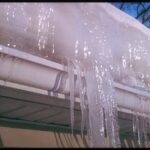What Are Ice Dams?

An ice dam is ice that forms at the roofs edge. The gutter become filled with ice and prevent melting snow (water) from draining off the roof. The water can back up behind the dam under the shingles and leak into the home causing damage to walls, ceilings, insulation and other areas.
Ice dams are a result of basically 3 conditions:
1) Snow on the roof
2) Heat loss from the building into the attic space
3) Nonuniform roof surface temperatures
This winter has been a long one in Calgary (2017-18). Lots of snow and extended periods of cold temperatures have taken a toll, especially on homes susceptible to ice dams. What happens is this:
The roof surface is warmer near the ridge than it is near the gutters. This is because heat loss from the house warms up the upper surface, while the areas over the soffits, stay cold. The snow melts, runs down the roof and re-freezes as it reached the gutters. This process continues (as long as it stays cold outside), until the gutters are full of ice and the water can no longer drain away. The more snow there is, and the longer it remains cold outside, the larger and more problematic the dams become. With a large snow load on a roof, the dams can become quite large and often dangerous, as large icicles can form.
How To Fix It?
Temporary Action: Remove the snow from the roof. Be careful not to damage the shingles. A roof rake can be used to safely remove the snow. We do not recommend walking on a roof covered in ice and snow, for obvious reasons.
Permanent Action: Seal all ceiling penetrations into the attic. Lighting fixtures, bathroom exhaust fans, attic hatch, speakers in ceilings, recessed lighting etc.. all need to be properly sealed to prevent heat loss. (See our blog on Attic Rain). Next, increase insulation levels and attic ventilation. This will keep the attic space cold and prevent the snow on the roof from melting. This will also cut down on your heating costs.

